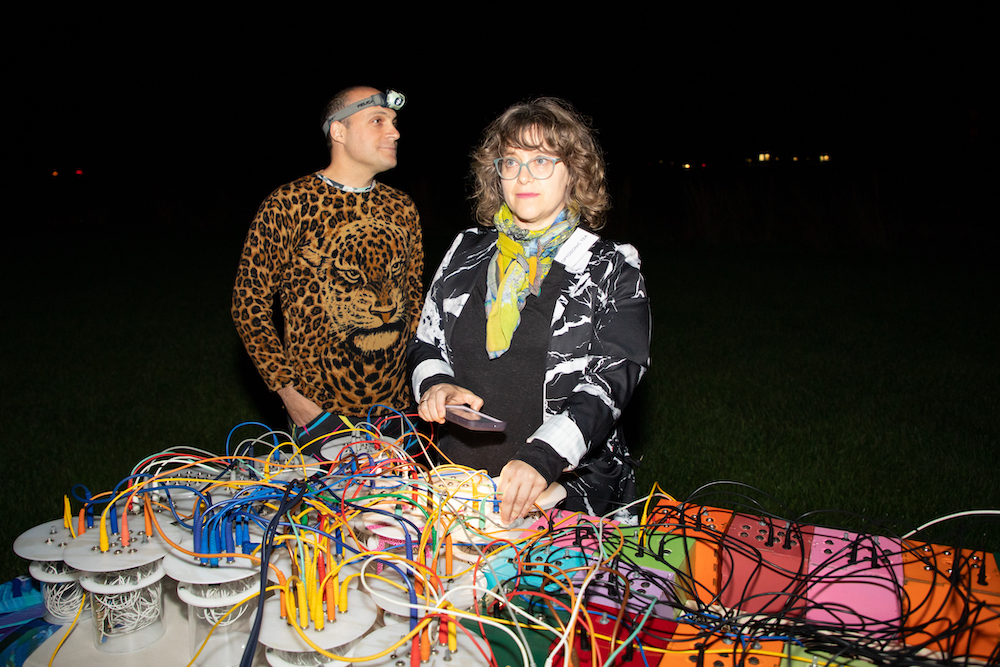Tali Hinkis and Kyle Lapidus began collaborating as LoVid in 2000. An alchemy of independent interests in technology has defined LoVid’s aesthetic, combining craft-oriented analog processes and playful engineering with natural and social science. LoVid’s live performances, participatory public art works, immersive installations, and video and textile projects express the radiant noise of an electrified but human world.
Inspired by a residency in 2003 at the Experimental Television Center (ETC) in Owego, New York, where LoVid had access to historical image-audio processing devices (including Nam June Paik’s “Wobbulator,” the Sandin Image Processor, and the Jones Colorizer), the duo began to create their own hand-built synthesizers, culminating in their main instrument, the Sync Armonica, constructed during a residency at Eyebeam in 2005. The reliance on unique, even cumbersome artistic tools is central to LoVid’s approach, which deliberately troubles the seamless aesthetics of new consumer technology to focus instead on the relatively crude texture produced by archaic devices.
LoVid’s interdisciplinary works explore the often invisible or intangible aspects of contemporary society, such as communication systems and biological signals. They are particularly interested in the ways technology seeps into the evolution of human culture.
LoVid’s practice includes performances, participatory public art, handmade technologies, textiles, prints, App-art, experimental video, and immersive installations. They focus on the juxtaposition of media with physical objects, geographic spaces, and the human touch. They are interested in bridging between handmade engineering and traditional art or craft forms by using a DIY philosophy and aesthetic. This allows them to reflect on the role of handmade production and the physical gesture of art-making in a time increasingly dominated by machines and virtual experiences. As a complementary part of their practice, they also apply machine-based and digital fabrication techniques that highlight our view of the critical importance of human/machine interaction in the digital age. Their diverse practice invokes processes and ideas from art, science, and technology, to question perceptions of time, place, and the self in the networked era.
LoVid’s collaboration began with audiovisual performances and has expanded to include a wide range of media, from prints to App-Art. LoVid’s performances were presented at the Museum of the Moving Image (NY), Graham Foundation (Chicago), Eyebeam (NY), MoMA (NY), FACT (UK), PS1 (NY), and The Kitchen (NY), among many others.
LoVid’s videos have been screened in galleries, festivals, and events worldwide, including Modern Art Oxford (UK), Art in General (NY), Siskel Theater (Chicago), International Film Festival Rotterdam (Netherlands), and NY Underground Film Festival (NY). LoVid’s installations and objects have been included in solo and group exhibitions worldwide, including The Neuberger Museum (NY), Netherlands Media Art Institute (Netherlands), Science Museum Jerusalem (Israel), CAM Raleigh (NC), Real Art Ways (CT), The Jewish Museum (NY), Science Gallery (Ireland), and New Museum (NY).
In addition, LoVid creates large-scale interdisciplinary projects that combine new technology with social interventions and public spaces. These have been supported by and produced in collaboration with Rhizome, Franklin Furnace, Elastic City, free103point9, The Robert Rauschenberg Foundation, Experimental TV Center, and LMCC. LoVid has received additional awards from NYSCA, NYFA, Foundation for Contemporary Art, and Greenwall Foundation. LoVid has participated in residencies with STEIM (Netherlands), Harvestworks, Eyebeam, Smack Mellon, and Cue Art Foundation.
About Collaborators
Tali Hinkis was born in Israel and studied fine art in the 1990s at the Ecole National Superieure des Beaux-Arts in Paris, and at Cooper Union, New York City. Before working as LoVid, her independent single-channel videos and collaborative performances were presented at the Center for Contemporary Art, Tel Aviv; Rencontres Internationales Paris/Berlin; the Knitting Factory, Tonic, and Exit Art, New York City; and many other venues. In 1998, Hinkis co-founded La Superette, an annual art, craft, and music event which ran for eleven years, hosted at venues including La Fleche d?Or, Paris; and Deitch Projects, Participant Inc., and Eyebeam, New York City. Hinkis has extensive experience teaching media literacy in public schools, and has held visiting artist positions at Columbia University, Stevens Institute of Technology, and Stony Brook University.
Kyle Lapidus is an artist and scientist. As an undergraduate at Harvard University, Lapidus studied neurobiology, electronic music, and engineering as part of the “Mind, Brain, and Behavior” focus. Subsequently, Lapidus was involved in experimental music and electronics design, performing in many bands while earning an MD and a PhD in Anatomy and Structural Biology at Albert Einstein College of Medicine. In 1993, Lapidus founded the micro-record label Ignivomous, which released noise music on vinyl and limited-edition cassette tapes and CD-Rs. Ignivomous incorporated as a non-profit in 2007, with a mission of presenting, nurturing, and developing new genres, art forms, mediums and extremes of expression.
